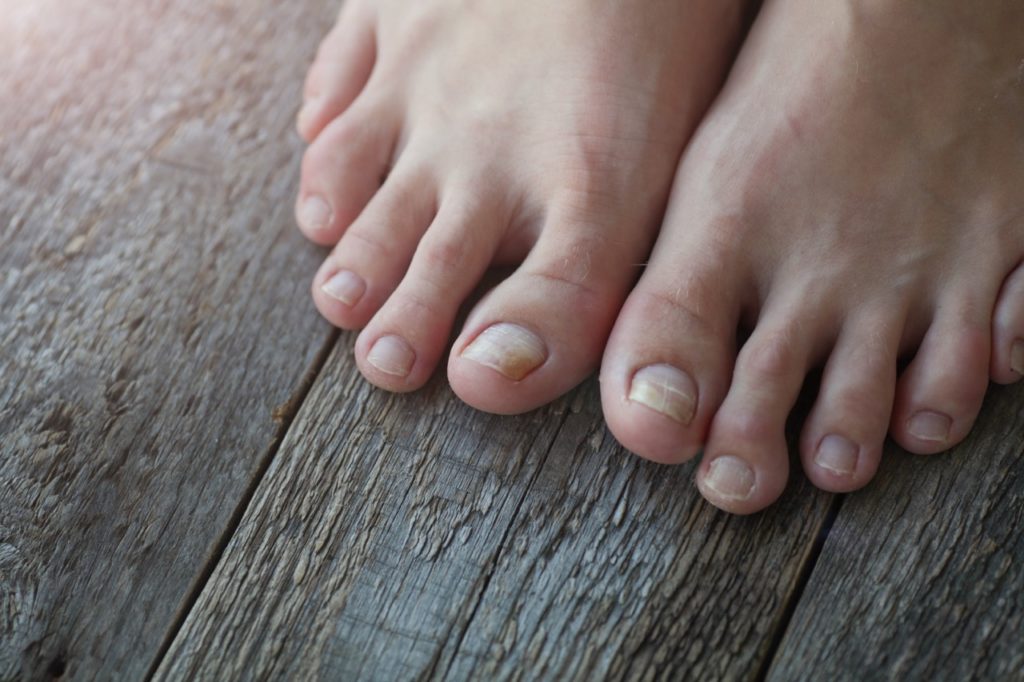Fungal nail infections, also known as onychomycosis, are a common problem that affects millions of people worldwide. While they may not be life-threatening, they can be embarrassing and affect individuals’ quality of life. In this blog ‘Embarrassed about fungal nail infections’, we will discuss what causes fungal nail infections, how to prevent them, and the available treatment options.
Understanding what caused your fungal nail infection
Definition and causes of fungal nail infections
Fungi are everywhere—from compost heaps to the mildew on roses—spreading by releasing spores into the air. Fungal nail infections occur when these spores contaminate the nails and begin to grow. The fungus invades the nail bed, leading to discolouration, thickening, and, over time, splitting or disintegration of the nail.
These infections thrive in warm, moist environments, such as within shoes and socks, and are often linked to poor hygiene or weakened immune systems. Fungal nail infections are more common in toenails than fingernails and are frequently associated with Athlete’s Foot. Fungi can infect the skin between the toes or under the feet, and ongoing dry skin problems may also indicate a fungal skin infection.
If left untreated, fungal nail infections can cause pain, irritation, and pressure on the surrounding skin. Losing a nail due to infection can also compromise its ability to protect the toe or finger from trauma. Early treatment is essential to prevent further complications and restore nail health.
Symptoms and effects on nail health
Fungal nail infections often present with symptoms such as thickened, discoloured, and brittle nails. As the infection progresses, it may emit an unpleasant odour.
Key signs of fungal nail infections include:
- Nails turning yellow-brown, becoming distorted or thickened, separating from the nail bed, or in severe cases, falling off.
- Slowed or halted nail growth.
- Pain, irritation, and pressure on surrounding skin, particularly when thicker nails create discomfort within shoes.
If left untreated, fungal nail infections rarely resolve on their own and can lead to more serious complications over time. Prompt attention is essential to prevent further issues.

How ‘cold’ laser treatment works for nail fungus
Cold laser treatment, also known as low-level laser therapy (LLLT), is a non-invasive and painless procedure that uses specific wavelengths of light to target and kill fungus cells in the nails. The laser energy penetrates through the nail plate without damaging surrounding tissue, targeting only the fungal infection. This method is highly effective in treating mild to moderate cases of nail fungus and has minimal side effects.
Mechanism of laser treatment for embarrassing nail fungus
For nearly a decade, Waverley Clinic in Farnham has been a trusted specialist in the effective treatment of fungal nail infections. Combining clinical expertise with cutting-edge cold laser technology, we deliver exceptional care and results for our patients.
Cold Laser Therapy offers a highly advanced, non-invasive, and pain-free solution for fungal nail infections affecting both toenails and fingernails. This innovative treatment works through two key mechanisms:
- The laser light targets the pigment in fungal cells, effectively destroying them through ablation.
- A secondary wavelength stimulates the immune system and nail growth cells, encouraging the development of healthy, new nails.
At Waverley Clinic, we utilise two of the most advanced cold laser systems available: K-Laser and Lunula Cold Laser Therapy. These state-of-the-art devices allow us to provide highly effective and precise treatment, ensuring the best possible outcomes for our patients.
Trust us to restore the health of your nails with expertise, technology, and care you can rely on.
Effectiveness of laser treatment for fungal nail infections
Cold laser treatment for nail fungus is a highly effective option, with studies reporting success rates of 80% to 90%. This safe and non-invasive alternative to oral medications eliminates the risk of serious side effects, such as liver damage. By targeting the fungal infection directly, cold laser therapy not only eradicates the fungus but also encourages healthy nail growth and helps prevent the infection from spreading. It can also be paired with other treatments, like topical creams, to address related conditions such as Athlete’s foot.
The treatment process
When you opt for cold laser therapy as a treatment for your fungal nail infection, there are several steps involved in the process. The first step is to consult with a licensed podiatrist or foot specialist who will assess the severity of your infection and recommend the appropriate treatment plan.
What to expect during the treatment
The first step is to schedule a fungal nail infection assessment to evaluate the condition and explore cold laser therapy options. During the procedure, the cold laser is carefully applied to the affected nail. The treatment is completely pain-free, though some patients may experience a mild warming sensation.
Typically, the therapy involves a series of sessions spaced 5-7 days apart. The exact number of sessions required depends on the severity of the infection and the individual’s response to the treatment, with most cases needing around five sessions.
One of the key benefits is that there’s no downtime—you can immediately resume work, daily activities, and sports after each session.
Preparation and aftercare instructions
Prior to treatment, patients should remove any nail polish and thoroughly clean the nail area. Following the procedure, it’s important to avoid using nail polish, particularly gel varnish. While long-term avoidance of nail polish is recommended, it may be used sparingly for short durations. To encourage healthy nail growth, patients should keep the treated area clean and dry. Additionally, topical creams or other treatments may be recommended to support and promote nail recovery.

Benefits of laser treatment for fungal nail infections
Research indicates that laser treatment is highly effective in addressing fungal nail infections, often achieving complete eradication of the infection in certain cases.
High success rate and long-term results
Laser treatment for nail fungus offers impressive success rates, with studies showing effectiveness between 80% and 90%. This treatment not only provides long-lasting results but also helps patients achieve complete clearance of the infection. Additionally, laser therapy promotes healthy nail growth while preventing the spread of the fungus. To minimise the risk of future infections, patients are provided with expert advice on maintaining foot health, as well as guidance on using anti-fungal products for shoes and socks.
Suitable for all ages and nail types
Laser treatment for nail fungus is a safe, non-invasive, and pain-free solution suitable for individuals aged 16 and older, regardless of nail type. This innovative cold laser therapy offers hope for those who have battled stubborn nail fungus for years, often after trying multiple treatments without success. Effective for both toenail and fingernail fungal infections, it provides a reliable and convenient option for achieving healthier, clearer nails.
Cost and value of laser treatment
Laser treatment for nail fungus may seem like a costly option compared to traditional treatments such as topical or oral medications. However, it offers many benefits that make it a valuable investment for those suffering from persistent fungal infections.
Factors affecting the cost of treatment
The cost of laser treatment for nail fungus varies based on several factors, including the severity of the infection, the size and location of the affected nail, and the number of sessions required. During a Fungal Nail Assessment appointment, the podiatrist will evaluate the extent and severity of the infection, explain the treatment process in detail, answer any questions, and provide a clear breakdown of the treatment costs.
Average cost and value for money
The cost of Cold Lunula Laser or K-Laser treatment for nail fungus typically ranges from £510 to £660, depending on the number of affected toes and the severity of the infection. While the price may seem significant, it is an important investment in your health and well-being. At Waverley Clinic, we utilise cutting-edge technology to offer advanced solutions for treating fungal nail infections effectively. When considering the cost, it’s important to weigh the benefits, including a high success rate and long-lasting results. Additionally, our expertise ensures you receive personalised advice to help prevent future infections and maintain healthy nails.

Choosing a qualified provider
When it comes to treating a fungal nail infection, it’s crucial to choose a qualified provider who has experience and expertise in this specific area.
Qualifications and experience in laser treatment
Patients seeking laser treatment for nail fungus should select a qualified Podiatrist with proven expertise in this procedure. It’s essential to ensure the Podiatrist has proper training and certification to perform the treatment safely and effectively. Prior to booking a consultation, take the time to review the Podiatrist’s credentials and experience to make an informed choice.
Alternatives to laser treatment
While laser treatment is a popular option for treating nail fungus, there are other alternatives available that may be more suitable for certain patients.
Other treatment options for fungal nail infections
Fungal nail infections can be treated through various methods, including oral medications, topical creams, or even opting for no treatment. It is important for patients to discuss these alternatives with their practitioner during the initial consultation. Carefully weighing the benefits and drawbacks of each option will help patients make an informed decision that best suits their needs.
Don’t feel embarrassed – Book your fungal nail laser treatment at Waverley Clinic today!
Lunula Laser and K-Laser Therapy offer a safe and effective solution for treating fungal nail infections. With a high success rate, these advanced treatments not only eliminate the infection but also encourage healthy nail growth while preventing its spread. At Waverley Clinic, our team of podiatrists bring nearly a decade of expertise in cold laser therapy, ensuring reliable assessments and treatment outcomes.

Choosing a qualified podiatrist with experience in post-treatment care is essential for receiving accurate, long-term advice to prevent future infections. While considering this treatment, patients should weigh the cost against the significant benefits of restored nail health and reduced risk of recurrence.
Don’t let fungal nail infections hold you back from living your life to the fullest. Book your appointment at Waverley Clinic today and say goodbye to stubborn fungal nails for good!
Schedule your appointment today!
Book Online or contact Waverley Clinic directly at: 01252 716611
We offer a convenient 24/7 telephone booking service, available seven days a week.

